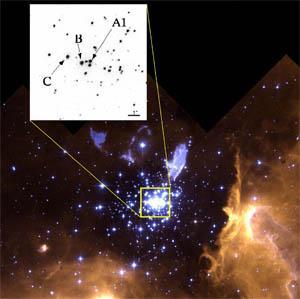The heaviest physicists 'scales' in the galaxy
The theoretical models of star formation have hypothesized the existence of extremely large stars that could reach 150 times the mass of the sun.
However, until recently, no scientist has discovered a star that is more than 83 times more massive than our sun. Currently, a group of celestial physicists led by researchers at Université de Montréal University, Center de recherche en astrophysique du Québec (CRAQ) discovered and discovered 'balance' by the biggest star until now on.
Olivier Schnurr, Jules Casoli and André-Nicolas Chené of Université de Montréal University along with professors Anthony FJ Moffat and Nicole St-Louis have finally succeeded in 'weighing' a binary star with mass 116 times the mass of the sun, 89 times more massive than the sun . This discovery has twice broken old records while breaking the volume limit of more than 100 solar masses for the first time.

Astrophysicists have finally succeeded in 'weighing' a binary star with a mass of 116 times the mass of the sun. Located in the giant constellation NGC 3603, the great star system known as A1 has a rotation period of 3.77 days. ( Photo: CRAQ)
Located in the huge constellation NGC 3603, the giant star system known as A1 has a rotation period of 3.77 days. The mass is calculated by combining observations made with the SINFONI device - a spectrophotometer placed in an extremely large telescope Very Large Telescope at the European Astronomical Research Organization (ESO) in the Southern Hemisphere, Chile. Infrared images taken by Hubble telescope.
The stars that make up the A1 system are so big and bright that the light they travel carries the characteristics that only Wolf-Rayet stars have. Wolf-Rayet star is a hot, huge and transformed star; it lost a lot of mass due to a strong stellar wind (similar to the solar wind). In the context of the study, a binary system that transmits X-rays at almost invisible energy levels in our galaxy is also found in NGC 3603 - A1.
Note: NGC 3603 is a giant HII region of the constellation Carina, located in the Carina arm of the spiral galaxy Milky Way 20,000 light years from the sun. Frederick William Herschel discovered it in 1834. NGC 3603 has a centralized area containing nearly 2,000 bright and large stars.
- Detection of wound healing of collagen in fish scales
- The sheep has the heaviest fur in the world
- Discovered 'evil galaxy' transparent like illusion
- Discover the farthest galaxy ever
- Discover the most 'cramped' galaxy
- The heaviest element is called Copernicum
- Hubble discovered the galaxy with brilliant lenses
- Proved Einstein's theory of relativity at the galactic level
- The scales are as hard as the armor of an Amazon arowana
- The discovery of new super galaxies is 160,000 times brighter than the sun
- The galaxy is 13.28 billion light-years from Earth
- Find the farthest galaxy
 Van Allen's belt and evidence that the Apollo 11 mission to the Moon was myth
Van Allen's belt and evidence that the Apollo 11 mission to the Moon was myth The levels of civilization in the universe (Kardashev scale)
The levels of civilization in the universe (Kardashev scale) Today Mars, the sun and the Earth are aligned
Today Mars, the sun and the Earth are aligned The Amazon owner announced a secret plan to build a space base for thousands of people
The Amazon owner announced a secret plan to build a space base for thousands of people The 'red monster' that Sima Qian mentioned caused illusions on Earth?
The 'red monster' that Sima Qian mentioned caused illusions on Earth?  This fruit has a sweet and sour taste that is as good as 'natural insulin', helping to lower blood sugar and nourish bones effectively.
This fruit has a sweet and sour taste that is as good as 'natural insulin', helping to lower blood sugar and nourish bones effectively.  A shooting star, about to explode in the sky of Earth?
A shooting star, about to explode in the sky of Earth?  Image of a new star spewing gas loudly across the Milky Way galaxy
Image of a new star spewing gas loudly across the Milky Way galaxy  The 'deadly' truth about strange radio signals transmitted to Earth
The 'deadly' truth about strange radio signals transmitted to Earth  Scientists Stunned to Discover Star With Supersonic Tsunamis Three Times Higher Than the Sun
Scientists Stunned to Discover Star With Supersonic Tsunamis Three Times Higher Than the Sun 